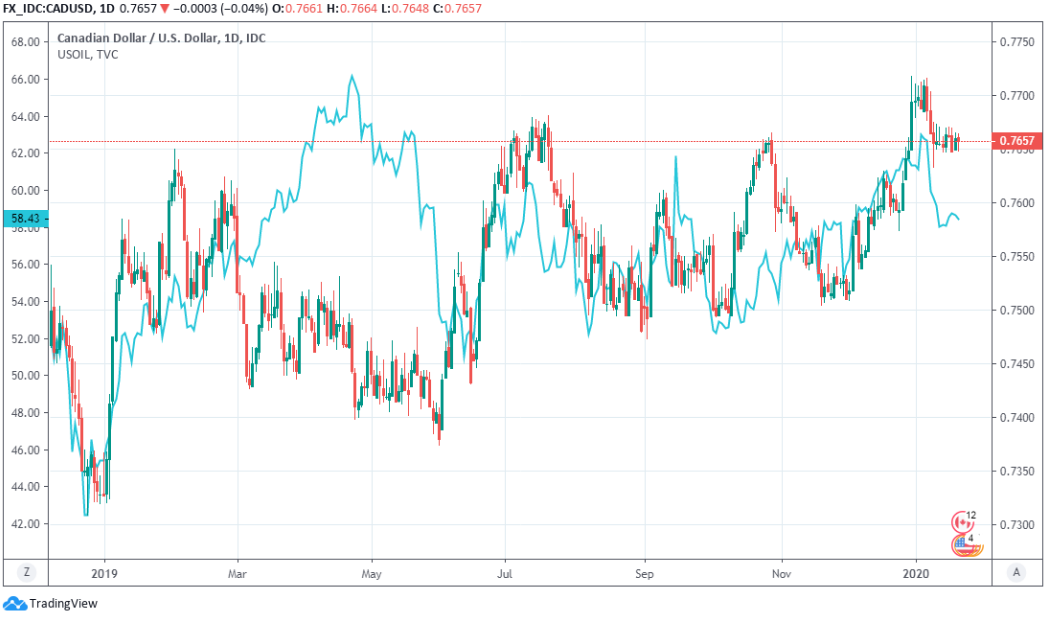Canadian Dollar Retreats as Coronavirus Fears Grip Markets, but Bank of Canada Dominates the Outlook
- Written by: James Skinner
-
- GBP sees best gain over CAD amid stock and oil weakness.
- As CAD retreats along with risk appetite on pandemic fears.
- Charts suggest GBP/CAD risks to downside, strategist says.
- But BoC rate statement to have final word on CAD outlook.

Image © Bank of Canada
- GBP/CAD Spot rate: 1.7089, up 0.21% today
- Indicative bank rates for transfers: 1.6481-1.6601
- Transfer specialist indicative rates: 1.6823-1.6925 >> Get your quote now
The Canadian Dollar retreated from Sterling and others rivals Tuesday amid declines in stock and commodity prices but Wednesday's Bank of Canada (BoC) interest rate decision is increasingly featuring on the market's radar.
Canada's Dollar has a notable but varying correlation with oil prices and stock markets, which were all sharply lower on Tuesday as investors panicked on news the coronavirus is being spread by human-to-human contact.
It's now feared the disease - which is similar to the SARS virus - is more infectious than previously thought, with it having spread as far as Japan and Thailand, while more than 100 cases have also been reported in Hong Kong.
At the time of writing, nine people are reported dead among the 440 people who are said to have contracted the corona virus.
Tuesday saw the first case reported in the United States by a man who had visited the Wuhan region in China. Chinese authorities are now stepping up efforts to limit the spread of the virus ahead of the travelling season around the Lunar New Year holiday.
"We have no way of assessing the potential for this story to drive a further mark down in risky assets from here, we can only highlight that the story can get far worse," says John Hardy, chief FX strategist at Saxo Bank. "It took a number of months for the SARS virus outbreak – a similar coronavirus – outbreak to die down back in late 2002 and well into 2003."
Above: CAD/USD rate and West Texas Intermediate (WTI) futures price (blue line, left axis), shown at daily intervals.
A pneumonia-like pandemic would have the capacity to severely hamper economic activity anywhere but there's now a risk of one in what is not only the world's second largest economy, but also its most populous country. That's why oil prices, other commodities and stock markets were all lower on Tuesday.
A CAD-negative external environment coincided with stronger than expected labour market data out of the UK to ensure the risk-sensitive Canadian Dollar recorded a large intraday loss against the Pound.
Above: Pound-to-Canadian Dollar rate shown at daily intervals.
The Pound-to-Canadian Dollar exchange rate climbed back above the 1.70 level on Tuesday while the USD/CAD rate lifted further off its post-October 2018 low of 1.2952 that was struck around the turn of the year. And with investors increasingly turning toward the looming Bank of Canada (BoC) interest rate decision and statement, due at 15:00 Wednesday, the Loonie may have its work cut out if it's to recover its footing in the short-term.
Consensus is looking for the BoC to leave its interest rate unchanged at 1.75% Wednesday but some observers are mindful the bank may turn its attention to the Loonie given recent strong increases in Canadian exchange rates. The Canadian Dollar has risen against eight of nine major rivals in the last year, with gains of nearly 2% over the greenback. It's also risen more than 6% against the Australian Dollar as well as more than 4% against the Kiwi and Euro.
"Our factor model continues to suggest that the broad USD gauge is the predominant driver for the loonie right now. We still envisage a tactical range of 1.3000-1.3300 holding for now and dips should lead to USD accumulation so long as the 1.2950 area isn’t taken out. There is a very good chance that the BoC may mention the loonie in its statement this week," says Bipan Rai, North American head of FX strategy at CIBC Capital Markets.
Above: USD/CAD rate shown at daily intervals.
Canada's currency has outperformed major rivals in the last year because resilience in the domestic economy and above-target inflation have enabled the BoC to leave its interest rate uchanged at 1.75% and helped make the Loonie the highest yielding major currency. The U.S. and Canada both have the same cash rates but Canadian 2-year government bonds pay investors a higher yield, which means they offer a greater return to those who hold the currency.
"We recommended tactically long USD/CAD exposure back on 8January. With USD/CAD around our estimate of medium term fair value, we continue to see scope for some risk premium to build over the near term, pushing the exchange rate temporarily higher to 1.32. Canadian economic data have notably softened, suggesting risk of a "catch down" to the struggling global economy," says Ben Randol, a strategist at BofA Global Research. "CAD appreciation will be self-limiting in the absence of improvement in CAD fundamentals."
Canadian bond yields are proving a draw for investors and the currency has risen but the economy is slowing rapidly at a time when inflation remains above the bank's target, stoking uncertainty about the BoC's likely tone on Wednesday. A rising currency could help to bring inflation back to the 2% target by reducing the cost of imports but it will also risk making Canada's exports less competitive, which might then further undermine the outlook for the economy.
"Our USD/CAD forecast remains 1.32 in 1Q, moderating to 1.31 by the end of 2020," Randol says. "Risks to the forecast are two-way. Upside risks are: global risk asset weakness, an unexpected deterioration in Canadian economic data, a more dovish BoC and renewed trade-related uncertainty adversely affecting global growth and capital flows. Downside risks are: a further decline in risk aversion and higher commodity prices driven by global reflation."








